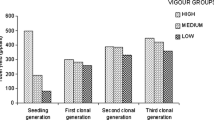Summary
Nine 2x clones with different genetic backgrounds and 2n pollen production by first division restitution (FDR) were each mated with five 4x females in a linextester design. Estimates of both general combining ability (GCA) and specific combining ability (SCA) were significant for tuber yield, among female and male parents. Four FDR clones with similar genetic background (half-sibs) showed significantly different GCA for total yield, illustrating the importance of progeny testing for FDR clones before their utilization as progenitors. A stronger influence of the 2x parents, compared to that of the 4x parents, on the performance of the hybrids was observed for characters studied. The significance of male and female interactions for characters other than tuber yield reinforced the importance of careful choice of the male and female parents for improving horticultural traits of 4x–2x progenies.
Similar content being viewed by others
References
Amoros, W. & H. A. Mendoza, 1979. Relationship between heterozygosity and yield in autotetraploid potatoes.American Potato Journal 56: 455 (abstract).
De Jong, H. & G. C. Tai, 1977. Analysis of 4x–2x hybrids in cultivated potatoes.Potato Research 20: 111–121.
De Jong, H., G. C. Tai, W. A. Russel, G. R. Johnston & K. G. Proudfoot, 1981. Yield potential and genotypesxenvironment interactions of tetraploid-diploid (4x–2x) potato hybrids.American Potato Journal 58: 191–199.
Federer, W. & G. F. Sprague, 1947. A comparison of variance components in corn yield trials. I: Error, tester x line, and line components in top-cross experiments.Journal of American Society of Agronomy 39: 453–463.
Hanneman, R. & S. J. Peloquin, 1969. Ploidy levels of progenies from 2x−4x crosses in potato.American Potato Journal 45: 255–261.
Haynes, F., 1980. Progress and future plans for the use of phureja-stenotomum populations. In: International Potato Center Report of the Planning Conference on Utilization of Genetic Resources of the Potato, III, p. 80–89.
Hermunstad, S. & S. J. Peloquin, 1985. Germplasm enhancement with potato haploids.Journal of Heredity 76: 463–467.
Howard, H. W., 1970. Genetics of the potato. Springer Verlag, New York.
Huaman, Z. & R. W. Ross, 1985. Updated listing of potato species names, abbrevations and taxonomic status.American Potato Journal 62: 629–641.
Iwanaga, M., 1980. Breeding at 2x level for combining pest and disease resistances using wild sp. and extracted haploids from selected tetraploid clones. In: International Potato Center Report of the Planning Conference on Utilization of Genetic Resources of the Potato, III. CIP, 1980, p. 110–124.
Iwanaga, M., 1984a. Potato breeding for combined resistance to tropical pests by the ploidy level manipulation approach: progress in extraction of haploids with male fertility and 2n pollen. In: Symposium of the International Society for Tropical Root Crops 6th, Lima, CIP, 1983, p. 481–486.
Iwanaga, M., 1984b. Discovery of a synaptic mutant in potato haploids and its usefulness for potato breeding.Theoretical and Applied Genetics 68: 87–93.
Iwanaga, M., 1985. Ploidy level manipulation approach. Development of diploid populations with specific resistances and FDR 2n pollen production. In: International Potato Center Report of the Planning Conference on Present and Future strategies for Potato Breeding and Improvement. CIP, 1983, p. 57–70.
Kidane-Mariam, H. M. & S. J. Peloquin, 1975. Method of diplandroid formation and yield progeny from reciprocal (4x−2x) crosses.Journal of The American Society for Horticultural Science 100 (6): 602–603.
Masson, M. F., 1985. Mapping, combining abilities and heterosis with 4x−2x crosses in potato. PhD thesis, University of Wisconsin.
Mendiburu, A. O. & S. J. Peloquin, 1977. The significance of 2n gametes in potato breeding.Theoretical and Applied Genetics 49: 53–61.
Mendoza, H. A. & F. Haynes, 1974. Genetic basis of heterosis for yield in the autotetraploid potato.Theoretical and Applied Genetics 45: 21–25.
Mendoza, H. A., 1980. Development of lowland tropic populations. In: International Potato Center Report of the Planning Conference on Utilization of the Genetic Resources of the Potato. III. Report of Planning Conference 1980. CIP. Lima Peru, p. 40–53.
Mok, D. W. S. & S. J. Peloquin, 1975a. The inheritance of three mechanisms of diplandroid formation in diploid potatoes.Heredity 35: 295–302.
Mok, D. W. S. & S. J. Peloquin, 1975b. Breeding value of 2n pollen (diplandroids) in tetraploid x diploid crosses in potato.Theoretical and Applied Genetics 46: 307–314.
Peloquin, S. J., 1979. Breeding method for achieving phenotypic uniformity. In: International Potato Center Report of the Planning Conference on the production of potatoes from true seed. Manila, Philippines, p. 151–155.
Schroeder, S. H., 1983. Parental value of 2x, 2n pollen clones and 4x cultivars in 4x−2x crosses in potato. PhD thesis, University of Wisconsin.
Singh, R. K. & B. D. Chaudhary, 1979. Biometrical methods in quantitative genetics analysis. Kalyani Publishers, p. 191–200.
Tai, G. C. C. & H. De Jong, 1980. Multivariate analyses of potato hybrids. I. Discrimination between 4x−2x hybrid families and their relationships to cvs.Canadian Journal of Genetics and Cytology 22: 227–235.
Veilleux, R. E. & F. I. Lauer, 1981. Breeding behavior of yield components and hollow heart in 4x−2x vs. conventionally derived potato hybrids.Euphytica 30: 547–561.
Author information
Authors and Affiliations
Rights and permissions
About this article
Cite this article
Ortiz, R., Iwanaga, M. & Mendoza, H.A. Combining ability and parental effects in 4x–2x crosses for potato breeding. Potato Res 31, 643–650 (1988). https://doi.org/10.1007/BF02361857
Accepted:
Issue Date:
DOI: https://doi.org/10.1007/BF02361857




